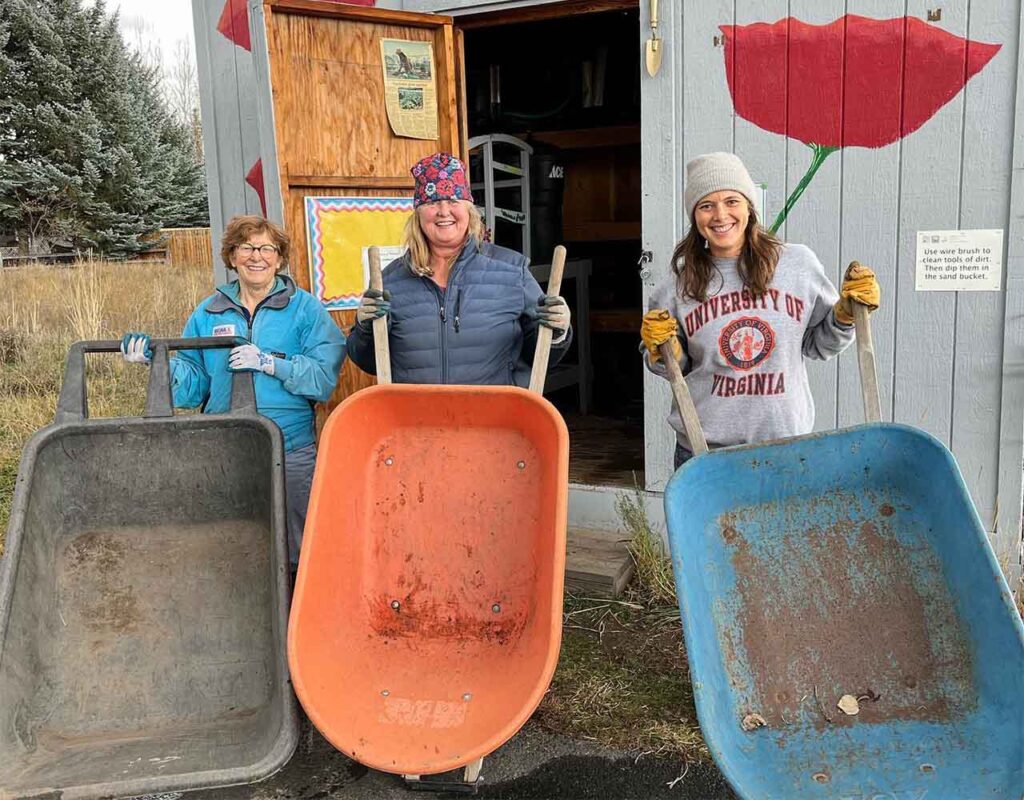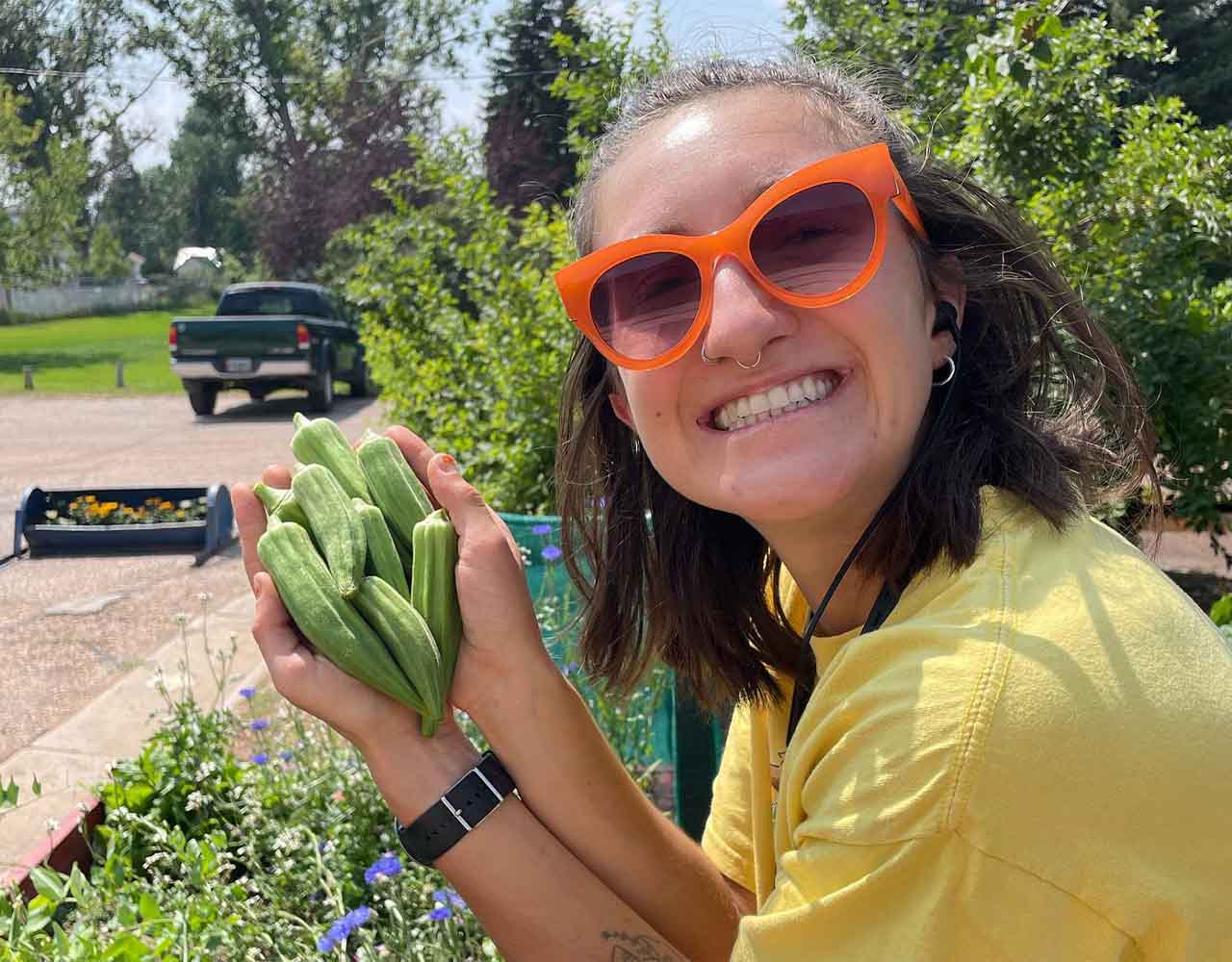Taking Your Gardening to the Next Level:
Tips and Resources from Those in the Field
"My garden is my most beautiful masterpiece."
- Claude Monet
Gardening can seem like a daunting task, especially here in Wyoming where the weather can change on a dime, and the wildlife are plentiful and hungry. But persevering through the challenges can lead to quantifiable accomplishment – true nourishment for the body, mind, soul… and even your community. The Hughes Charitable Foundation asked the experts of Feeding Laramie Valley and Slow Food in the Tetons to share some insights and resources into Western gardening.
Tips and resources from Scott Steen, Executive Director of Slow Food in the Tetons
What tips or advice do you have to those starting their own home garden?
Ask for help from an experienced friend or community member! Don’t be afraid to plant in this climate. You can’t go wrong. Every experience is valuable and even the most experienced gardeners learn something new every season. Plant garlic or other over-winter crops in the fall that will survive under the snow and come up early in the spring to give you a jump start on the season.
What other helpful resources do you recommend to beginner gardeners and food producers in Wyoming?
University of Wyoming Gardening Resources Page and Master Gardener Program Teton Conservation District provides some great native plant resources and grants for gardeners, farmers etc. Connect with your local farmers, ranchers and gardening experts through farm visits, educational workshops offered by several local organizations, and Slow Food programming. We share this local resource list and high alpine gardening video with community gardeners each spring.
The Teton Farmer Fund aims to increase the amount of healthy, locally grown food in the community by providing support to local farmers. Who can apply to the Teton Farmer Fund?
The 2024 Teton Farmer Fund will be open for applications by mid November of 2023. This year we granted a total of $55,000 to nine farms to support projects that strengthen our community food system. Much of that funding came from Hughes Charitable Foundation.
Our eligibility requirements to apply for the Teton Farmer Fund are as follows:
- The Teton Farmer Fund is only available to local and regional food producers. Local is defined as grown within 100 miles or less from Jackson, WY. Regional is defined as grown within 250 miles or less from Jackson, WY.
- Producers must generally adhere to good, clean, and fair food principles.
- Preference is given to producers that participate in Slow Food programming.
Where can you take any extra produce or food you grow?
If you have a surplus of home grown food and would like to sell at our weekly farm stand please reach out to sara@tetonslowfood.org to sell produce. Contact Hole Food Rescue to donate produce, or connect with your Jackson Cupboard through One22. The Community Gardens program donates to Sage Living Center at St. John’s Hospital. Some local restaurants may purchase seasonal produce, go to their back door during the day. Share with your neighbors and community!
What are some ways you can show your support for Slow Food in the Tetons and personal, small, and mid-scale gardening and agriculture in Wyoming?
Make a donation here to Slow Food in the Tetons to support our work! Even though over half of our funding as a non-profit comes from program generated revenue, we do rely heavily on donations to run our many amazing programs. More information about our programs, fundraising and finances can be found here in our Program and Impact Report.
Or, consider volunteering at one of our programs like the People’s Market or Slow Food Farm Stand. Email marketplace@tetonslowfood.org to learn more.
Attend the Slow Food Farm to Fork Festival in Jackson in early October to hear food and agriculture related keynotes, presentations, and workshops and discover the many ways to connect, support and get more involved in the Teton area food system.
Read more about Slow Food in the Tetons’ full impact here.
Helpful advice from Gayle M. Woodsum, Founder & Lina Dunning, Director of Community Engagement of Feeding Laramie Valley
What can gardeners expect to experience in Wyoming?
Even the most experienced gardeners will tell you that gardening in Wyoming is an everyday experiment — always has been, and always will be. Most especially in the state’s high-elevation and mountain areas, gardening challenges include short growing seasons, poor soils, destructive winds, hail and wildlife, all of which can be managed with the right knowledge and planning. Depending on the size of the garden, they may experience an increase in their city water bill. As daunting as this is, scientific research and personal experience repeatedly shows that backyard and community gardening in Wyoming brings countless benefits: significant contribution of delicious, healthy, fresh produce to the household; diet-related disease prevention and intervention (such as diabetes and heart disease); and maybe most rewarding, a profound contribution to good mental health and a sense of overall well being. There’s nothing quite like a summer evening spent with your hands in the dirt, pulling jewels like bright yellow summer squash or rich potatoes from the earth for dinner.
What are some common mistakes beginner gardeners might make?
As rewarding as it is, gardening takes work – garden preparation, planting, weeding, daily watering, harvesting, protection from bad weather and pests.
- It can be tempting to create a large garden — to dream bigger than a beginning gardener is prepared for. One or two raised beds or a few large containers with your favorite vegetables is a great way to become knowledgeable and successful without becoming discouraged.
- Another common misconception is thinking that once a garden is planted, it can grow on its own. Gardens can’t take a vacation and survive. Some beginning gardeners think they can take a week’s vacation or garden only on the weekends, only to discover their garden plants have died while they were away. Gardens must be watered and tended to every day, so a garden-sitter must be secured when the gardener is away.
- It can be tempting to plant early before the last frost date, but this often results in great losses due to freezes. Furthermore, gardeners can lose fragile new plants overnight if they are not protected from the wind.
- Beginning gardeners should get their soil tested in order to know what nutrients they need to add. Their local extension agent (part of the University system and available across Wyoming in many communities) can help with guidance on how to get testing done and how to interpret the results.
Where can you take any extra produce or food you grow?
Many gardeners share with friends, neighbors and family, soup kitchens, and other organizations offering free meals such as summer camps, vacation bible schools, food banks that are equipped to refrigerate fresh food, and sustainable food-security organizations like Feeding Laramie Valley in Laramie and Food for Thought Project in Casper.
How does learning how to garden benefit the community?
Like so many important needs, it takes a community to create sustainable, local healthy food security, and backyard and community gardening provides a substantial contribution by ensuring the availability of locally produced fruits and vegetables rather than relying predominantly on having food trucked in from far away. Personal gardening also benefits the gardener economically, allows cash to be freed up for other purposes, and contributes to community wealth. Gardeners who preserve part of their food for later use have something to fall back on when grocery store supplies are low due to roads being closed or there are supply chain challenges. Local gardening ensures a healthier citizenry, assists with productive water use, and increases the amount of green space to improve air quality.
FLV Resources for HEALTHY EATING:




